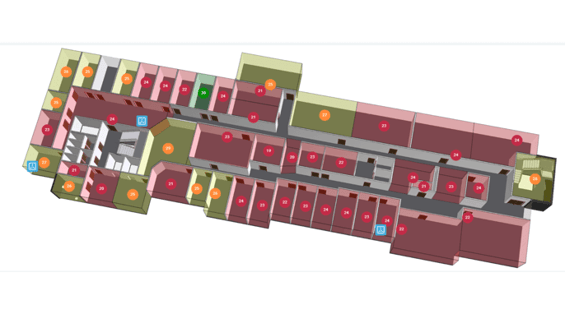
 Tommy Hagenes is Business Development Manager at Airthings for Business. He has expertise in Building Management Systems (BMS), PropTech and how to build a sustainable business model. This content was originally published by Tu.no in Norwegian. For the original article click here.
Tommy Hagenes is Business Development Manager at Airthings for Business. He has expertise in Building Management Systems (BMS), PropTech and how to build a sustainable business model. This content was originally published by Tu.no in Norwegian. For the original article click here.
In response to the Norwegian government's announcements, kindergartens and schools are slowly beginning to open up again. Commerce is on the rise and offices are slowly being used where possible. The Norwegian Labour Inspection Authority has provided updated recommendations for offices prior to opening.
The new recommendations are specific to the current situation, and can be found here.
What is interesting, is the The Norwegian Labour Inspection Authorities guidance 444, does not in all aspects reflect the same changes.
Many buildings are not adapted to the new recommendations. The consequence of this can be very costly both investment costs and increased operating expenses. This is a concern both for companies that own commercial buildings or have an office.
Most people in commercial buildings are familiar with The Norwegian Labour Inspection Authorities guidance 444. It provides guidelines for the indoor environment in an office building, however it is quite generalised. For example, it sets the temperature requirements in offices to between 19 and 26 degrees celsius, but we know that tenants rarely accept this. It also mentions air speed (movement), air exchange (l / s) and air quality with CO2 limits of 1000ppm. Radon and its requirements are referred to in the TEK (Technical Building Regulations), but humidity is only mentioned in a statement regarding moisture damage or the venting of building material. Unfortunately, it does not set humidity requirements.
"Surprisingly, there was no requirement for humidity in guidance 444" - Tommy Hagenes
Building owners with local humidifiers are generally more concerned about keeping humidity levels under 30% in the wintertime as they are worried about condensation risk and moisture damage from the humidifiers. Whereas low humidity is often not a cause for concern.
The recommendations state “Consider the possibility of changing the ventilation rate and lowering the temperature if relative humidity is below 30% in summer and 20% in winter1.”In other words, it is advisable here that relative humidity should be above 30%. Yet interestingly, the same cannot be found in Authorities guidance 444.
 I recently started diving into the topic of relative humidity and asked the question; was it the building, the inventory or the people who are most important in a building. I referred to Proptech Bergen which at the time stated a relative humidity of 16-17% which is quite common in Norwegian buildings during winter. We took steps in an office with a local humidifier, getting the humidity up to 40%, but this was only in a single office, and not the entire building. So how should we act on the advice of the The Norwegian Labour Inspection Authority now?
I recently started diving into the topic of relative humidity and asked the question; was it the building, the inventory or the people who are most important in a building. I referred to Proptech Bergen which at the time stated a relative humidity of 16-17% which is quite common in Norwegian buildings during winter. We took steps in an office with a local humidifier, getting the humidity up to 40%, but this was only in a single office, and not the entire building. So how should we act on the advice of the The Norwegian Labour Inspection Authority now?
It’s positive that we now focus on the indoor environment, how it affects people and not just the building. This probably means that in the future buildings will adapt to new requirements, but on the negative side 80% of all buildings that will be in use in 2050 are already built, so the challenge will be todays’ offices.
Setting recommendations for a higher relative humidity is reasonably easy, and measuring it in 2020 with all the available sensors is also straightforward. However, solving the problem is difficult.
The reason for the low relative humidity in Norwegian commercial buildings in winter is that we have cold and dry outdoor air that we heat and bring into our buildings. When exchanging large amounts of air, we are unable to significantly increase the humidity which has a meaningful effect on people or plants. This means that our new builds have a relative humidity that ranges between 10-13% on the worst days. During the winter it is seldom that we have more than 30% relative humidity. Clearly humidity is debated these days and there is a lot of new research being made. For example, there is a project called “40to60RH.com” which states that if we increase relative humidity to between 40-60% it will save lives and encourage the World Health Organisation to act.

To be able to set typical Norwegian buildings’ humidity, humidifiers must be installed. But the truth is that very few buildings have humidifiers today. Humidifiers are typically used in hospitals due to the risk of infection, or museums to prevent damage to artwork from low humidity. Normally office buildings do not have humidifiers and the sad truth is that we have traditionally thought more about the building than the humidity and the people.
So how do we move forward? Do landlords have to resort to costly renovations of technical facilities after having reduced their rent and perhaps even losing some tenants to bankruptcy? Will they have the opportunity to achieve this, or will it be a bit like radon, in that we know there is a problem, but some choose not to measure? 
When looking at new building standards such as Well, (which is a standard that focuses more on health and well-being than standards such as Breeam), data on indoor climate should be transparent and preferably visible on information screens. This is a trend we see. We are much more transparent today. Considering that a sensor costs relatively little and that professional solutions can be set up in minutes, I am quite sure that most tenants see indoor climate as an important part of the office infrastructure. I think it's going to be hard to ignore the recommendations that are coming now.
Those who have children in kindergarten have experienced how opening hours and pick-up times have changed. The daily office routine, most likely, will not seem normal at first. - Tommy Hagenes
So then what should we do in Norway? It is very likely that a technical solution for the entire building will not be in place. And I doubt that most Facility Managers have the finances or the opportunity to make such an investment now. By autumn, will we hoard humidifiers like we did paper in March? During testing at Proptech Bergen, this solved the problem in the short term, but then the water tank had to be refilled daily. Additionally, control can quickly be lost if an overall system that looks at humidity for an entire building is not in place.
As I mentioned, The Norwegian Labour Inspection Authorities new recommendations places a substantial focus on maintaining a certain relative humidity levels, which also becomes a delicate balancing act; and I personally think this is not the solution. To increase humidity many may choose humidifiers as an option. As a building owner I would see it as a risk to have several standalone humidifiers in an office. But to have a system that manages the best humidity for comfort, and also have sensors to control, I would think that would be a good solution.
The home office has become the norm recently. Maybe the biggest challenge has been juggling work and home schooling children. If schools and kindergartens are open, I personally think many would agree that office workers in particular, can do a good job at home rather than the office. We have been through a digital journey where we have taken a figurative "10-year jump" in a few weeks, and most have seen the opportunities to be productive from home. Perhaps this is a take away, something we can do for a few days a week, or that we travel to the nearest building instead of the other side of town.
In addition to focusing on humidity, the recommendation is that the ventilation system should run all or most of the day. In practice, this means that if you do not have advanced controls to count occupancy, you can quickly double the cost of energy, maintenance and wear on the ventilation system while also spending much more energy on heating as the air is often delivered undercooled. Today buildings’ HVAC systems are typically set to run for 12 hours per day, usually from 6:00 am to 6:00 p.m. The authorities recommend extending the core period, while at the same time run the ventilation system when people are present. If you have no knowledge of this, and you want to make a risk assessment, you will end up running the system 24 hours a day. Very often, the tenant pays this cost.
This will create an even greater distinction between "conventional" and "smart" buildings, where you can often see a joint cost that is double that of the "conventional" buildings. - Tommy Hagenes
Should the Labor Inspectorate present such guidelines which are required of landlords? Who will pay for the doubling of energy costs and do we have the infrastructure to withstand the burden this will lead to in our cities? Is it "the new offices" that offer short-term rentals, more locations and an adapted environment that will "boom"?
One thing is for certain, real estate technology (PropTech) has come a long way since 2019. We have taken the "digitization leap", and now the buildings must do the same! The Norwegian Labour Inspection Authority update their recommendations often, so for the latest information on what they recommend, please check here.